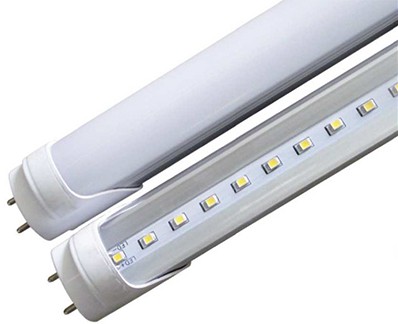
Linear fluorescent tube lamps are one of the most commonly used lamps in commercial settings. Offices, shopping malls, schools, warehouses, restaurants etc. have hundreds if not thousands of linear fluorescent lamps lighting these facilities. These facilities can benefit enormously by switching to linear LED lamps or T8s (Or T12s, T5s etc). In fact, many have already switched and others are in the process of doing so.
Before you switch to LEDs, you will face one tricky question: What type of linear LED T8 lamp is the best option for retrofitting? Below is my attempt to simplify and describe some of the options available in the market.
There are currently three types of linear LED lamps in the market:
- Type A (Plug and Play): Lamps which operate using the existing fluorescent electronic ballast.
- Type B (Internal Driver): Lamps that require line voltage to be wired directly to a fluorescent fixtures sockets.
- Type C (External Driver): Lamps that require an external dedicated driver to operate. Similar to Type B, but the driver is outside the tube
Some of the pros and cons of these products are listed below.
Type A – Plug and Play: This is the easiest way to retrofit. These LED lamps are compatible with most electronic ballasts found in fluorescent tube light fixtures. The plus side is simply the installation side, just take out the old tube and put in the LED one. No rewiring needed and you do not have to be an electrician to do this. These are also eligible for saveONenergy incentives in Ontario.
Drawback: These only work with the ballast. Once the ballast malfunctions or reaches its lifespan, these tubes won’t work until a new ballast is installed. By choosing this option which retains a used ballast of unknown quality, the fixture may continue to need costly and frequent maintenance.
Type B – Internal driver: The integrated driver approach is fairly straightforward but requires some rewiring of the fixture. Depending on the type of control gear that is in place, electrician will simply need to modify the existing fluorescent control and bypass electronic ballasts completely to wire the lamp end caps directly to mains voltage. Basically the ballast is by passed and removed from the fixture.
Drawback: the internal driver approach also requires that all the electronics must be housed within the confines of the LED tube. The lifetime of the LED driver could be negatively impacted by using smaller components to fit in the restricted space. In addition, the excess heat generated as a result of putting the driver into the LED tube raises the overall temperature of the tube and reduces the lifespan of the LEDs. Extra weight of the internal driver could also pose some risk as lamps might fall out of the sockets.
Type B LED tubes are no longer eligible for saveONenergy incentives in Ontario!
Type C – External Driver: that is based on the fluorescent concept where a single external LED driver runs one or more LED tubes, can comfortably include any dimming and smart features required.
The external-driver approach should offer better reliability, a longer life span and a safer product. Choosing a complete luminaire solution with an external driver means any safety or lifespan concerns are removed. The entire system – the lamp, the lamp holder and the driver will be designed to work together.
Drawback: Retrofitting with external driver Linear LED tubes means there is extra hardware, i.e. in a typical situation, you would need one driver for every two tubes. Basically, this option will cost more than the first two.
Author: Onkar Gill
onkar@ledsolutions.ca





